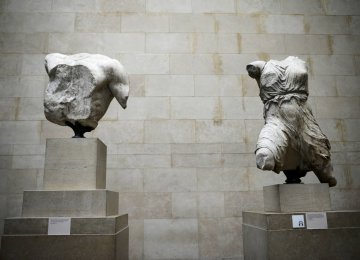Greece wants the Parthenon Marbles back from the British Museum, Prime Minister Alexis Tsipras said in London on Tuesday, trying to reinvigorate a longstanding campaign for the 2,500-year-old treasures.
British diplomat Lord Elgin removed the sculptures from the Acropolis in Athens in the early 19th century when Greece was under Ottoman rule. They comprise roughly half of the 160-meter-long frieze that was on the Parthenon temple.
Since independence in 1832, Greece has repeatedly requested their return, albeit without success, Reuters reported.
Tsipras, who was on his first official visit to London since he was elected in 2015, said the issue is of particular ethical importance for Greeks and he raised the matter when he met his British counterpart Theresa May.
“The Marbles belong to the world cultural heritage but their natural place is the Parthenon,” he told reporters.
Britain has resisted campaigns for the return of what it calls the Elgin Marbles along with treasures from other countries including Nigeria and Ethiopia, often citing legislation that bans its museums from permanently disposing of their collections.
Greece has stepped up its campaign since 2009 when it opened a new museum at the foot of the Acropolis hill, saying this answered any suggestion that Athens lacks a suitable place to preserve the marbles.
The museum hosts priceless relics from the Acropolis, including the Caryatids, standing columns in female form. There is space for one of the six missing figures, on display at the British Museum.
In 2014, a previous Greek government hired a legal team including human rights lawyer Amal Clooney to advise it on its bid to secure the return of the marbles.
Parthenon Marbles (also known as the Elgin Marbles) are a collection of Classical Greek marble sculptures. They were originally part of the temple of the Parthenon and other buildings on the Acropolis of Athens.
One of the world’s greatest cultural monuments, the Parthenon is a former temple, on the Athenian Acropolis, Greece, dedicated to the goddess Athena. Construction began in 447 BC when the Athenian Empire was at the peak of its power. It was completed in 438 BC. It is the most important surviving building of Classical Greece, generally considered the zenith of the Doric order. Its decorative sculptures are considered some of the high points of Greek art.






Add new comment
Read our comment policy before posting your viewpoints